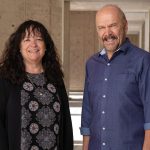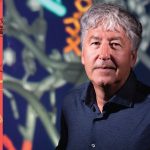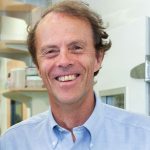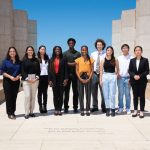Observations Gerald Joyce An organizing force
Gerald Joyce was appointed Salk’s senior vice president and chief science officer earlier this year. But long before then, he referred to himself as “a Salkie deep in the veins.”
Joyce was born in Kansas and grew up in Chicago. He went to college at the University of Chicago and then earned both his MD and PhD at UC San Diego. When it came time to do his PhD thesis research, Joyce walked across the street to Salk—or what his glossy UC San Diego recruiting brochure had called “The Castle”—and joined the lab of one of the Institute’s original Resident Fellows, Professor Leslie Orgel.
After finishing his medical degree and clinical internship, Joyce returned to the Institute for his postdoctoral training, during which time he and his wife were married in the Salk Courtyard.
Joyce went on to serve as dean of the faculty at Scripps Research and institute director of the Genomics Institute of the Novartis Research Foundation (GNF) before returning to Salk yet again in 2017, this time as a professor.
Joyce’s research has long focused on the chemistry and biochemistry of RNA, or ribonucleic acid. At Salk, his lab is interested in two key questions: How did life begin? And can we restart it in the laboratory?
Inside Salk sat down with Joyce to learn about the evolution of RNA, as well as the evolution of his career, science, and Salk.
How did you become interested in studying the origins of life and evolution?
GJ: The summer after my sophomore year, I drove an industrial laundry truck to factories around Chicago to help pay my way through college. It was hard labor, but at lunch I was always reading. A turning point for me was Thomas Pynchon’s book Gravity’s Rainbow. It starts out quite depressing—it’s about how the universe is inevitably moving toward a state of chaos and nothingness. But then the book pivots to the organizing force, or “Titans of the Earth,” which opposes the destructive force. It’s a natural process that takes us away from physical randomness and toward biological invention and organization. And, of course, that process is Darwinian evolution.
So that was my new motivation—I wanted to summon the Titans of the Earth by engineering the organizing force. When I came back for my junior year, I turned to biochemistry and molecular genetics so I could understand how one can evolve complex living systems starting from random molecules. That fascinated me, and it still does.
Why did you decide to pursue both a medical degree and PhD?
GJ: I love science, but it was the late 1970s when I was finishing college, and there was a lot of instability in the world, to say the least—the oil embargo, runaway inflation, a hostage crisis. I just felt like the whole world as we knew it might collapse. Maybe young people have that same fear now. But it made me second-guess my decision to become a Darwinian engineer in such a world. I figured I needed a skill, and no matter how bad things get, we always need doctors.
While research is my focus, to this day I do keep my medical license active. I spent seven years running a drug discovery team at Novartis, and it turns out that being a licensed physician and having that medical training enables you to engage in drug discovery beyond the basic science, to understand what’s going to
happen if and when that therapeutic compound gets to the clinic.
What’s so special about RNA?
GJ: These days everybody talks about RNA because we are fortunate to have RNA-based vaccines to protect us against COVID-19, but my take on RNA is more ancient than that. Before there were cells or other complex biological structures, it’s thought that life was based on replicating RNA molecules.
That idea was born here at the Salk Institute. In 1968, then Salk Fellows Francis Crick and Leslie Orgel were good friends and frequently enjoyed lunches together out on the patio. The pair were founding members of the discipline now known as molecular biology. They were at the forefront of figuring out, at a molecular level, how biology works—from DNA (our genetic material) to RNA (the messenger material) to proteins (the functional material). Over their lunches, Crick and Orgel came to the conclusion that it all very likely started with just RNA. RNA was once the only show in town: a molecule that both contained genetic information and had function. They laid out the concept of what is now called “the RNA World,” the idea that biology in the ancient world, roughly 4 billion years ago at the dawn of life, was based on RNA.
What is “test-tube evolution,” the focus of your research today?
GJ: If we can understand what life is and how it began, then maybe we can restart it ourselves in the lab. We’re not talking about Frankenstein’s monster—not an organism or even a cell. We’re simply talking about a chemical system that is capable of undergoing self-sustained Darwinian evolution. And my lab has achieved that, at least in a limited way. We have devised RNA enzymes that replicate and evolve in the test tube. Our current aim is to make that process more robust so that it supports broader evolutionary inventiveness.
With this so-called “test-tube evolution,” we and others are devising molecules that can affect disease-causing pathways for potential applications in clinical diagnostics and therapeutics. Take, for example, Humira, the best-selling drug for rheumatoid arthritis and psoriasis—it is an antibody protein that was developed using test-tube evolution.
How might your work relate to life beyond Earth?
GJ: When you start thinking about the origins of life, you also start thinking about what is and isn’t “life.” How do you define it? Everyone has their favorite notion, but there is no agreed-upon scientific definition of what life is. And yet it’s a problem we’re all interested in, particularly when we start exploring other planets. If we’re looking for signs of life, what exactly are we looking for? And how will we know when we’ve found it? Over the years I’ve helped advise on these concepts for groups like NASA, their Jet Propulsion Laboratory, and the US National Academy of Sciences.
What kept you coming back to Salk?
GJ: There are three types of biological research institutions: universities, which focus on education and training the next generation of scientists and scholars; academic medical centers, which have responsibility to care for patients; and then there are the independent research institutes, like Salk.
Of course, it’s important to teach and provide medical care, but someone needs to focus solely on generating the new basic discoveries upon which everything else is built. That’s where independent research institutes play a critical role, and of those, Salk is among the most prominent in the world.
Just like with my work on RNA and the origins of life, I like being at the very beginning of the process.
How do you think science itself has evolved over your career?
GJ: Science has definitely changed—for the better. When I was a student and a postdoc in the 1980s, every laboratory was sort of its own little world. They would collaborate, of course, especially at Salk, but it was still mostly an individual effort. Now science is done differently, for three main reasons: constantly evolving technology platforms, the necessity of forming interdisciplinary teams before you even begin to address a research question, and “big data.” Thanks to all this technology and collaboration, we now harvest and analyze far more data than we could have even stored back then.
As chief science officer, what’s your vision for the future of Salk?
GJ: Our prime objective has always been to produce high-impact science—that’s why we’re here. But we need to evolve as science evolves. To ensure that Salk will always lead the world in fundamental discovery research, we now have an exciting, comprehensive fundraising campaign underway that is focused on six critical research areas: cancer, healthy aging, plant biology, immunobiology, neuroscience, and computational biology. We are recruiting the best people and building the technology and research space that we need to create new opportunities in these areas.
The investments we make today will launch a thousand ships tomorrow. I can’t wait to see what we will achieve together.
Support a legacy where cures begin.
Featured Stories
 Human Connection – How social interaction and isolation influence our physical and mental healthSalk neuroscientists study how our brains allow us to experience, interpret, and interact with the world around us. Many of these researchers are now studying not only the brain alone, but the brain in a social context.
Human Connection – How social interaction and isolation influence our physical and mental healthSalk neuroscientists study how our brains allow us to experience, interpret, and interact with the world around us. Many of these researchers are now studying not only the brain alone, but the brain in a social context. Salk scientists lead $126 million effort to map the aging human brainThe largest grant in Institute history has established the new Center for Multiomic Human Brain Cell Atlas to detail the many individual cells that make up the human brain—their molecular features, where they are found, and how they change with age.
Salk scientists lead $126 million effort to map the aging human brainThe largest grant in Institute history has established the new Center for Multiomic Human Brain Cell Atlas to detail the many individual cells that make up the human brain—their molecular features, where they are found, and how they change with age. Gerald Joyce—An organizing forceJoyce was appointed Salk’s senior vice president and chief science officer in early 2022. Inside Salk sat down with him to learn about his research on the evolution of RNA, as well as the evolution of his career, science, and Salk.
Gerald Joyce—An organizing forceJoyce was appointed Salk’s senior vice president and chief science officer in early 2022. Inside Salk sat down with him to learn about his research on the evolution of RNA, as well as the evolution of his career, science, and Salk.
 A life in service to science and others: Walter Eckhart exemplified generosity and kindnessEckhart, professor emeritus and director of the Salk Institute’s National Cancer Institute-designated Cancer Center and head of the Molecular and Cell Biology Laboratory for more than 30 years, died on June 21, 2022, at his home in La Jolla, California, at the age of 84.
A life in service to science and others: Walter Eckhart exemplified generosity and kindnessEckhart, professor emeritus and director of the Salk Institute’s National Cancer Institute-designated Cancer Center and head of the Molecular and Cell Biology Laboratory for more than 30 years, died on June 21, 2022, at his home in La Jolla, California, at the age of 84.  Georg Heinrich “Heini” Thyssen-Bornemisza—Salk Institute mourns loss of influential former Board memberThyssen’s leadership and generosity helped accelerate scientific efforts at the Institute over the years, always with a focus on allowing Salk scientists to continue their pursuit of high-risk, high-impact research. He died on September 30, 2022.
Georg Heinrich “Heini” Thyssen-Bornemisza—Salk Institute mourns loss of influential former Board memberThyssen’s leadership and generosity helped accelerate scientific efforts at the Institute over the years, always with a focus on allowing Salk scientists to continue their pursuit of high-risk, high-impact research. He died on September 30, 2022. Mallory Zaslav—Valuing the differences in backgrounds and experiencesAs vice president of Diversity, Equity & Inclusion, Zaslav’s forward thinking and advocacy have given shape to a range of impact-driven programming and outreach, furthering Salk’s mission of bettering humanity by pushing the boundaries of innovation and discovery.
Mallory Zaslav—Valuing the differences in backgrounds and experiencesAs vice president of Diversity, Equity & Inclusion, Zaslav’s forward thinking and advocacy have given shape to a range of impact-driven programming and outreach, furthering Salk’s mission of bettering humanity by pushing the boundaries of innovation and discovery. Katia Troha—Discovering diets that boost survival during infectionGrowing up in Peru, Troha’s love of science was fueled by documentaries on groundbreaking studies like the first cloned mammal, Dolly the sheep. She is now a postdoctoral researcher in the Salk lab of Professor Janelle Ayres.
Katia Troha—Discovering diets that boost survival during infectionGrowing up in Peru, Troha’s love of science was fueled by documentaries on groundbreaking studies like the first cloned mammal, Dolly the sheep. She is now a postdoctoral researcher in the Salk lab of Professor Janelle Ayres. Heithoff-Brody High School Summer Scholars program paves the way for future scientistsFor more than 30 years, Salk’s Heithoff-Brody High School Summer Scholars program has provided hands-on laboratory experiences for local high school students interested in exploring careers in science, technology, engineering, and math.
Heithoff-Brody High School Summer Scholars program paves the way for future scientistsFor more than 30 years, Salk’s Heithoff-Brody High School Summer Scholars program has provided hands-on laboratory experiences for local high school students interested in exploring careers in science, technology, engineering, and math.



















































